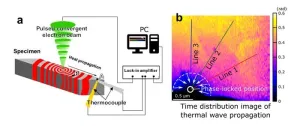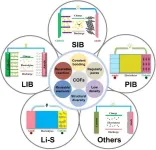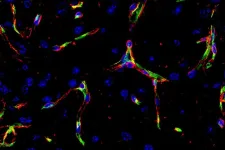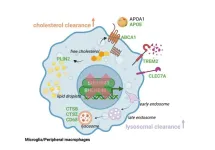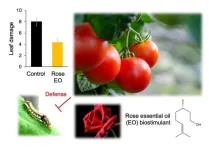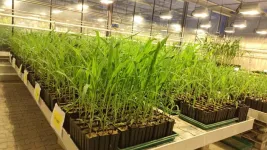(Press-News.org) We are used to computers getting faster and faster, but complicated calculations involving lots of data can take a very long time, even today.
This applies to calculations of chemical reactions, how proteins assume different three-dimensional forms and so-called phase transitions, where one chemical substance transitions from one state to another, such as from solid to liquid form.
These types of results are often very important – for example, in the chemical industry.
Down from one year to ten days
These complicated calculations can take years to perform, and access to the most powerful computers is limited. How nice would it be if someone could make the calculations faster? Maybe a lot faster? And using existing equipment?
“We have managed to increase the calculation speed of chemical reactions by 30-40 times,” says Titus van Erp, a professor at the Norwegian University of Science and Technology (NTNU’s) Department of Chemistry. If sufficient computing resources are available, the speed can be increased even more.
Van Erp headed the research group that performed this study, but what does it mean in practice?
“A calculation that previously took one year can now be done in ten days,” says the professor.
The example in question concerned a calculation of how water molecules are split into hydrogen and oxygen.
This also means that the researchers can now perform computer calculations that would previously have been impractical and perhaps impossible to carry out. The results have been published in PNAS, the Proceedings of the National Academies of Science.
Connected computers are smarter
So how have they done this?
“We connected 20 computers that could work together to perform the calculations,” says van Erp.
Connecting computers together is nothing new, but the way the researchers did this is completely different from what others have done.
“We modified the algorithms, which optimized the exchange of data between the machines,” van Erp said.
Because the computers could work actively much more of the time, there was much less delay during the calculations.
The computers don’t have to wait
“Previously, connected computers spent a lot of time waiting for each other. One computer in a network has had to wait for calculations being performed by another computer in the network, but they don’t have to do that in our method,” says van Erp.
This is especially important at a time when current computer technology is starting to reach a limit. The increase in speed is no longer as fast as it was a few years ago and results like this are, therefore, important, necessary and encouraging.
The research group further consisted of lead authors Daniel T. Zhang and Lukas Baldauf, and Anders Lervik from the Department of Chemistry at NTNU, as well as Sander Roet from Utrecht University, who was a PhD student at NTNU when they carried out the experiments.
Reference: Daniel T. Zhang, Lukas Baldauf, Sander Roet, Anders Lervik and Titus S. van Erp. Highly parallelizable path sampling with minimal rejections using asynchronous replica exchange and infinite swaps. PNAS. 5 February, 2024. https://doi.org/10.1073/pnas.231873112
END
Connecting computers so they can think faster
Better hardware can make computers faster, it's true. But linking them in specific ways can also speed them up.
2024-03-21
ELSE PRESS RELEASES FROM THIS DATE:
In-situ observation of nanoscale heat propagation
2024-03-21
1. A NIMS research team has developed a technique that enables the nanoscale observation of heat propagation paths and behavior within material specimens. This was achieved using a scanning transmission electron microscope (STEM) capable of emitting a pulsed electron beam and a nanosized thermocouple—a high-precision temperature measurement device developed by NIMS.
2. Public interest in energy conservation and recycling has grown considerably in recent years. This change has inspired scientists to develop next-generation materials/devices capable of controlling and utilizing heat with a high degree of precision, including thermoelectric devices able to ...
Recent advances and perspectives of covalent organic frameworks for alkali-ion batteries
2024-03-21
They published their work on Mar. 15th in Energy Material Advances.
"It is highly necessary to design highly conductive and high-performance materials for application in alkaline ion batteries," said paper author Xijun Xu, associate Professor at the College of Chemical Engineering and Light Industry, Guangdong University of Technology.
"In recent years, with the development of large-scale power systems such as electric vehicles, the demand for secondary batteries has gradually shifted towards high power and low cost. Furthermore, in light of the increasing energy and environmental concerns, the exploration of green and renewable ...
Limitations and strategies towards high-performance red phosphorus materials for Li/Na-Ion batteries
2024-03-21
They published their work on Mar. 15th in Energy Material Advances.
"The development of cost-effective and high-performance RP anode materials for LIBs/SIBs is imperative," said paper author Hailei Zhao, professor with the Beijing Key Lab of New Energy Materials and Technology, School of Materials Science and Engineering, University of Science and Technology Beijing, "Despite RP shows a great potential, the inherent poor electrical conductivity of RP (~10-14 S cm-1) and significant volume changes during charge/discharge processes (> 300%) compromise its cycling stability."
Zhao explained that the poor electrical conductivity ...
New geological study: Scandinavia was born in Greenland
2024-03-21
In a Finnish outcrop nestled between some of Northern Europe's oldest mountains, researchers have found traces of a previously hidden part of Earth's crust that points more than three billion years back in time and north towards Greenland.
These traces were found in the mineral zircon, which after chemical analyses, indicated to researchers from the Department of Geosciences and Natural Resource Management that the "foundation" upon which Denmark and Scandinavia rest, was probably 'born' from Greenland approximately 3.75 billion years ago.
"Our data suggest that the oldest part of Earth's crust beneath Scandinavia originates ...
Research offers hope for preventing post-COVID ‘brain fog’ by targeting brain’s blood vessels
2024-03-21
Among the many confounding symptoms in patients recovering from a COVID-19 infection are memory loss and difficulty learning. Yet little is known about the mechanisms of cognitive impairments like these, commonly called brain fog.
In a new study, researchers at the University of Illinois Chicago have identified a mechanism that causes neurological problems in mice infected with SARS-CoV-2, the virus behind COVID-19. The researchers also found a treatment that helped prevent these changes. Sarah Lutz, assistant professor of anatomy and cell biology in the College of Medicine, led the research, ...
Non-culturable Legionella identified with sequencing
2024-03-21
Highlights:
Legionnaires’ disease is a rare and dangerous respiratory tract infection.
Diagnoses and surveillance usually require culturing isolates.
A new study shows how whole genome sequencing could be used when culturing isn’t an option.
The work points to new avenues for public health surveillance of infectious diseases.
Washington, D.C.—Legionnaires’ disease (LD), a rare and severe type of pneumonia, is a respiratory infection caused by species of Legionella bacteria. One of the most accurate ways to diagnose LD is to perform culture on samples from a patient’s lower respiratory tract, but those samples are difficult ...
Immune cells identified as key players in brain health
2024-03-21
New York, NY [March 21, 2024]—Using novel genetic and genomic tools, researchers at the Icahn School of Medicine at Mount Sinai have shed light on the role of immune cells called macrophages in lipid-rich tissues like the brain, advancing our understanding of Alzheimer’s and other diseases. The study, published in the March 6 online issue of Nature Communications [DOI: 0.1038/s41467-024-46315-7], represents a step forward in understanding immune cell regulation and its impact on disease progression.
The researchers initially studied genes controlling macrophages, also referred ...
Rose essential oil: A safe pesticide for organic agriculture
2024-03-21
Plants-derived essential oils (EOs) find applications in various industries, such as detergents, cosmetics, pharmacology, and food additives. Moreover, EOs have an exceptional safety profile, and their numerous bioactivities greatly benefit human health. Beyond these benefits, EOs have also been found to illicit insect-repellent responses by inducing neurotoxic effects.
Terpenoids are abundant in plant EOs and have garnered widespread attention as they can regulate plant defense responses by regulating the expression of defense genes. For example, soybean and komatsuna plants, when grown near mint, experience a significant improvement in defense properties ...
Researchers identify novel genetic variants associated with Alzheimer’s disease
2024-03-21
Contact:
Jillian McKoy, jpmckoy@bu.edu
Michael Saunders, msaunder@bu.edu
##
Identifying genetic variants and the role they play in predisposing people to Alzheimer’s disease can help researchers better understand how to treat the neurodegenerative condition for which there is currently no cure. A new study led by Boston University School of Public Health (BUSPH) and UTHealth Houston School of Public Health has identified several genetic variants that may influence Alzheimer’s disease risk, putting researchers one step closer to uncovering biological pathways to target for future treatment and prevention.
Published in the journal Alzheimer’s ...
Research team identifies genetic contribution to the composition of the microbiome around maize roots
2024-03-21
In order for plants to grow, they absorb water and nutrients through their roots. In doing so, they rely on tiny helpers: bacteria and fungi in particular are found in a thin layer around the roots. These microbes also ward off organisms that are harmful to the plant, just as the "microbiome" in the human gut helps determine whether we fall ill or stay healthy.
An international research team led by the University of Bonn and with the participation of the IPK Leibniz Institute has now demonstrated on maize plants that the genetic make-up of the host plant has a significant influence on the composition of the root microbes. "It was shown ...
LAST 30 PRESS RELEASES:
Tracing the quick synthesis of an industrially important catalyst
New software sheds light on cancer’s hidden genetic networks
UT Health San Antonio awarded $3 million in CPRIT grants to bolster cancer research and prevention efforts in South Texas
Third symposium spotlights global challenge of new contaminants in China’s fight against pollution
From straw to soil harmony: International team reveals how biochar supercharges carbon-smart farming
Myeloma: How AI is redrawing the map of cancer care
Manhattan E. Charurat, Ph.D., MHS invested as the Homer and Martha Gudelsky Distinguished Professor in Medicine at the University of Maryland School of Medicine
Insilico Medicine’s Pharma.AI Q4 Winter Launch Recap: Revolutionizing drug discovery with cutting-edge AI innovations, accelerating the path to pharmaceutical superintelligence
Nanoplastics have diet-dependent impacts on digestive system health
Brain neuron death occurs throughout life and increases with age, a natural human protein drug may halt neuron death in Alzheimer’s disease
SPIE and CLP announce the recipients of the 2025 Advanced Photonics Young Innovator Award
Lessons from the Caldor Fire’s Christmas Valley ‘Miracle’
Ant societies rose by trading individual protection for collective power
Research reveals how ancient viral DNA shapes early embryonic development
A molecular gatekeeper that controls protein synthesis
New ‘cloaking device’ concept to shield sensitive tech from magnetic fields
Researchers show impact of mountain building and climate change on alpine biodiversity
Study models the transition from Neanderthals to modern humans in Europe
University of Phoenix College of Doctoral Studies releases white paper on AI-driven skilling to reduce burnout and restore worker autonomy
AIs fail at the game of visual “telephone”
The levers for a sustainable food system
Potential changes in US homelessness by ending federal support for housing first programs
Vulnerability of large language models to prompt injection when providing medical advice
Researchers develop new system for high-energy-density, long-life, multi-electron transfer bromine-based flow batteries
Ending federal support for housing first programs could increase U.S. homelessness by 5% in one year, new JAMA study finds
New research uncovers molecular ‘safety switch’ shielding cancers from immune attack
Bacteria resisting viral infection can still sink carbon to ocean floor
Younger biological age may increase depression risk in older women during COVID-19
Bharat Innovates 2026 National Basecamp Showcases India’s Most Promising Deep-Tech Ventures
Here’s what determines whether your income level rises or falls
[Press-News.org] Connecting computers so they can think fasterBetter hardware can make computers faster, it's true. But linking them in specific ways can also speed them up.

